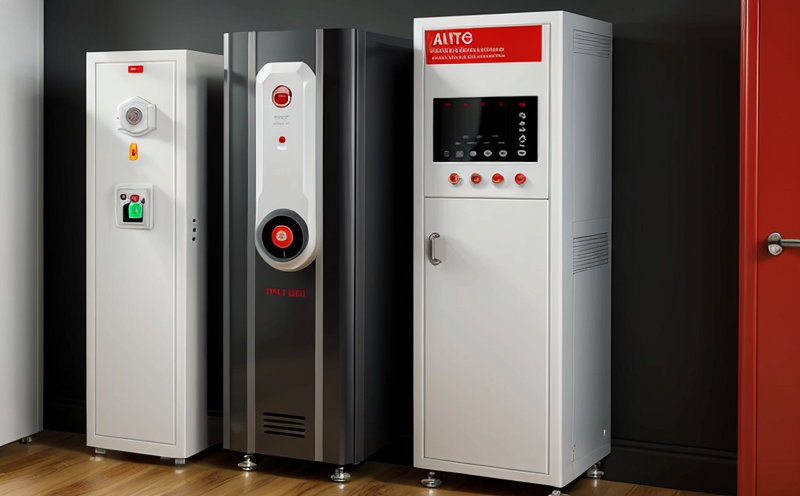ISO 7240-5 Heat Detectors Performance Testing
The ISO 7240-5 standard provides a comprehensive framework for testing heat detectors used in fire safety systems. This service is essential for ensuring that these devices meet international quality and performance standards, thereby enhancing the reliability of fire detection and alarm systems.
Heat detectors are designed to respond to increases in ambient temperature caused by a fire. They play a crucial role in early-stage fire detection, which can significantly improve the effectiveness of firefighting efforts and reduce property damage and casualties. The ISO 7240-5 standard ensures that heat detectors operate reliably under various environmental conditions and with different types of fires.
The testing process involves subjecting heat detectors to a series of controlled temperature increases, simulating real-world fire scenarios. This allows us to evaluate the detector's sensitivity, response time, and ability to differentiate between genuine fires and false alarms (nuisance alarms). Compliance with ISO 7240-5 is mandatory for manufacturers aiming to sell their products in markets that adhere to international standards.
Our laboratory follows a rigorous testing protocol that includes the use of calibrated heating elements, temperature-controlled environments, and standardized test specimens. The goal is to simulate real-world conditions as closely as possible while maintaining strict control over variables such as ambient temperature, humidity, and air velocity. This ensures accurate and repeatable results.
The testing procedure typically involves exposing heat detectors to a range of temperatures that correspond to different fire stages: pre-flashover, flashover, and post-flashover conditions. By subjecting the detectors to these conditions, we can assess their performance in various phases of a fire's development. This approach provides valuable insights into how well the detectors will perform under actual fire scenarios.
One of the key aspects of ISO 7240-5 testing is the evaluation of the detector's sensitivity and response time. The standard defines specific criteria for these parameters, such as the temperature threshold at which a detector should activate and the maximum allowable delay between the onset of fire conditions and the activation of the alarm system. Compliance with these criteria ensures that heat detectors respond promptly and accurately to fires, minimizing the risk of undetected hazards.
Another critical factor in ISO 7240-5 testing is the ability of heat detectors to differentiate between genuine fires and false alarms. False alarms can lead to unnecessary evacuation, panic, and resource wastage, while undetected fires can result in severe damage and loss of life. The standard includes tests designed to evaluate a detector's selectivity, ensuring that it responds only to actual fire conditions.
In addition to the primary testing procedures outlined in ISO 7240-5, our laboratory also offers extended testing services tailored to specific client needs. These may include additional environmental factors such as humidity, dust levels, and air currents, which can affect a detector's performance. By incorporating these variables into our testing protocols, we provide clients with comprehensive data that reflects the real-world conditions in which their products will be used.
The results of ISO 7240-5 testing are meticulously documented and reported to our clients. Each report includes detailed information on the detector's performance under various test conditions, including sensitivity, response time, selectivity, and any deviations from expected behavior. This data is invaluable for manufacturers in identifying areas for improvement and ensuring their products meet or exceed international standards.
By adhering to ISO 7240-5 testing protocols, clients can ensure that their heat detectors are reliable, efficient, and compliant with global fire safety regulations. This not only enhances the overall performance of fire detection systems but also contributes to the protection of lives and properties in potentially hazardous environments.
Applied Standards
| Standard | Description |
|---|---|
| ISO 7240-5:2019 | Performance testing of heat detectors in fire safety systems. |
Scope and Methodology
The scope of ISO 7240-5 Heat Detectors Performance Testing encompasses a detailed evaluation of the detector's performance under various temperature conditions. This includes testing the device's sensitivity, response time, and ability to differentiate between genuine fires and false alarms.
| Methodology | Description |
|---|---|
| Temperature Control | The testing environment is precisely controlled to simulate different stages of a fire, including pre-flashover, flashover, and post-flashover conditions. |
| Sensitivity Testing | Detects the lowest temperature at which the detector activates. This helps ensure that the device responds promptly to potential fires. |
| Response Time Evaluation | Evaluates the time taken for the detector to activate from the start of a fire scenario until the alarm is triggered. |
| Selectivity Assessment | Determines the detector's ability to differentiate between genuine fires and false alarms, such as those caused by electrical equipment or environmental factors. |
International Acceptance and Recognition
The ISO 7240-5 standard is widely recognized and accepted in the fire safety testing industry. Compliance with this standard ensures that heat detectors meet international quality and performance criteria, which is essential for manufacturers aiming to export their products globally.
Many countries have adopted ISO standards as part of their national regulations, making compliance a key requirement for fire detection system components. By adhering to ISO 7240-5 testing protocols, clients can ensure that their heat detectors are not only reliable and efficient but also fully compliant with international standards.
The acceptance of these tests extends beyond mere regulatory requirements; it reflects the commitment to excellence in fire safety technology. This standard is particularly important for manufacturers who operate across multiple regions or countries with varying fire safety regulations. By ensuring that their products meet ISO 7240-5, they can confidently enter new markets and gain a competitive edge.
The widespread adoption of this standard also benefits end-users by providing them with high-quality, reliable heat detectors that perform consistently across different environments. This ensures that fire safety systems are effective in protecting lives and properties worldwide.





